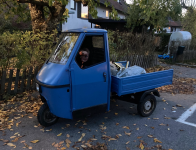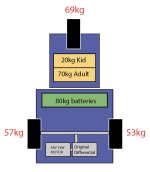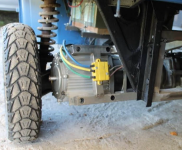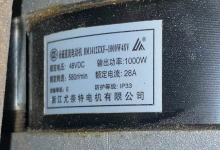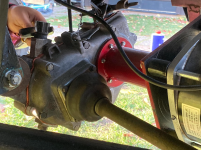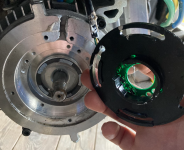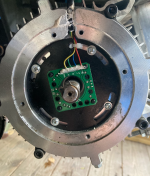The first controller I bought burned quite quickly and it was later confirmed that that controller was a 500W controller rather than 1000-1300W according to this review: https://www.youtube.com/watch?v=88SOQoiZzCU – That is fine. Lesson learned.
FWIW, the controller is what controls the power used, so it should not be damaged by being a lower power controller even if you have a load much higher than it can power. It should just not give you the power you need to do what you want, if it's properly designed. (of course, really cheap ones may not be).
The *motor*, if undersized for the power used thru it, could certainly get burned up.
The batteries, if undersized for the current pulled from them, will sag in voltage excessively and so the system won't have the speed it should. Lead acid probably won't be damaged by it (unless this is sustained long enough to cause enough internal heating to boil electrolyte) but lithium batteries can overheat and be damaged, or even start a fire if the heat/damage is severe enough...so it's important to size the battery to *easily* handle the full worst case load it will ever see, even as it ages.
* Slow top speed (13km/h)
That can be insufficient power (too small a controller) if the terrain, rolling resistance, wind resistance, etc. require more power to go faster.
Or it can be too low a voltage for the motor's kV (rpm/volt) / the wrong winding of motor (kV) for the voltage you have to use, to get the RPM output required to drive the transmission and thus the wheels at the RPM needed for the speed you're after.
(for instance, the max RPM of that motor at the voltage it's spec'd at 580RPM--if that is not as high as the original engine's output RPM, then this motor at this voltage will never go as fast as the original did, by the ratio of the new to the original RPM--I didn't look around ATM to try to find out what that original RPM is, but I'm sure it's out there somewhere).
When top speed is ok once it reaches it but it slows down on any even slight upward slope (worse the steeper it is) then it can also be battery voltage sag from insufficient battery capability for the power required of it (the battery must be able to supply all the powe the system will ever need, and preferably significantly (25-50%, at least) more so it is not under stress and can still do so as it ages).
* Can not handle a simple hill.
By "simple", what is it's slope and length?
You'll need to know those, plus the total weight of the vehicle and anything it must carry (including you), and the speed you want to maintain on the hill, to find out how much power it will require, at minimum, to climb it (you need the length to know how long it must maintain that power and guesstimate the Wh it will take from the battery, which affects your range).
So we've got the weight at 350kg. What's the slope, and the speed you must maintain?
(the http://ebikes.ca/tools/simulator.html can be used to guesstimate the power required once we know those, using various pre-listed parts or custom if necessary).
Note that if you were to add a multispeed gearbox between the motor and the transaxle input, the gearbox itself will eat up some small percentage of the power you have available, but having the gears, properly used while driving, will help you climb hills better as long as you can accept a proportionally slower speed on hills vs flat roads, for the same power usage on each.
* Bad controller which did not provide enough power/current?
* Bad wiring of hall-sensors?
* Bad battery setup? (12V lead acid batteries in series)
* Too heavy batteries?
* 1kW is not enough?
To eliminate various possibilities, we'll need to figure out how much power it takes to do what you want with it first.
So I have now ordered this controller which will arrive 12th of November: https://www.aliexpress.com/item/1005004105836465.html
Just a couple notes based on the specs they list, presuming your chosen item is the first "color" box of "60V-72V-3000W-80A". Note that E-HP and APL both use a similar design controller in their recent threads, if you want some info on internals/etc. Specs are below my comments.
I didn't see anything that indicates which are peak ratings, and which are continuous. The 80A, at 72v, would be 80 x 72 = 5760W. If the controller can continuously handle that, then there aren't any problems...if it can only momentarily handle that, then if it self-limits after that moment to what it can handle, no problem. If it can only momentarily handle that, but it does *not* self limit after that point, and it's parts are simply not good enough to do it, but the demand continues, it'll eventually overheat and fail. I only bring it up because they call it a 3000w controller, which means that it should have about a 40A current limit, half of what they say it is.
Your battery will have to be able to supply all that current for as long as the load demands it. Without the specs for the batteries you're presently using, I can't tell you if they're suitable for this or not.
The single-mode no self learning means that it only works with sensors (no sensorless mode) and it will require you to manually find the correct phase/hall wiring combo. To do that block the wheels offground and run the controller at very low throttle, while monitoring battery current to the controller. Try different combinations utnil it runs in the right direction with no undue noise (with sinewave it should only have planetary gearbox and transaxle gearbox noise), at the lowest current. Once you find what seems correct, increase throttle slowly until you reach full RPM and it remains quiet and current remains low. At a guess you should see 2-3A, maybe a few more (because of the gears/transaxle); if it's a lot more than that it's probably not the right combination.
Undervoltage of 52v means that it will shut off when battery pack voltage drops to that. For a 60v pack that's fine, but for a 72v pack it's too low--it may damage a 20s lithium pack (if it had no BMS to shutdown before the 2.6v/cell that would end up at) and would overdischarge a 6s (x12v) lead pack, too, down to around 8v/battery.
The Attention stuff probably means you should use a fuse on the controller's battery input so that if it blows up it won't short circuit your battery; size the fuse for the max current your battery wiring and battery itself can handle; that should be higher than any current the system should see under normal usage. (don't want the fuse to blow just using it). Make sure all the bolts are tight for all the wire connections. Controller is not waterproof, so don't put it where it will get wet, but put it where it will have good airflow (these are usually contradictory requirements). Active cooling (fans on the heatsink) will help with airflow if it can't simply be put out where it will get that from passing air as you drive, or if airspeeds are too slow to remove the heat.
They list 1000-2000V motor, they probably mean W not V. But only recommending that small a motor means the controller may not be nearly as powerful as it says it is, *or* it may mean it's ratings are only for peak usage, and can't sustain more than 1000-2000W very long. You'll have to find out which is true when you test the system.
Soft and hard start refers to throttle response--soft start means it ramps up slowly no matter how quickly you try to accelerate, hard start should mean it follows your throttle action "instantly".
Third gear probably means a two-wire single-button three-speed switch to toggle between three different settings, but whether those are speed limits or power limits or some other thing it doesn't state--you'll have to test them to find out.
General instrument, who knows--it may mean almost anything, at a guess it is a single-wire speedometer output intended for a "scooter" style display, probably at battery voltage (so not safe to use with displays that require 5v levels). Could mean it has a serial output that sends info to a display, but that will be specific to whatever display it's designed to use (they're not all intercompatible, so you'd want to get the display along with the controller as a kit to be sure they work together).
Antitheft usually is a form of wheel-lock-via-braking. A controller I've got here, when that is enabled, will not do anything until you try to roll the wheel. Then it actively fights rotation by attempting to power itself in the opposite direction.
High brake means you connect the brake wire to your brake light wiring, assuming a commmon ground between traction battery and lighting battery, so it activates whatever braking mode it has whenever the brake light comes on, so you don't need to add a switch for this.
Current limit: 70A/80A/90A
Voltage: 60-72v universal
Undervoltage: 52V
Phase angle: 120° (single mode, no self-learning)
Size: length width height 22*11*5.5cm
Functions: toggle third gear, reverse, cruise, anti-theft device, high brake, general instrument, soft and hard start, E-ABS electronic brake
Suitable motor: recommended 1000-2000v motor
Attention: The car must be installed with the main gate, the wiring must be connected well during the wiring process, and the screws must be tightened before powering on! Pay attention to waterproofing during use, and do a good job of heat dissipation.
The new controller is 60V-72V 3000W and I am hoping to have a successful overvolting of the engine. I am planning to have this experiment monitored and will be adding a DS18B20 temperature sensor as close to the stator winding I can.
See this thread for some potentially helpful notes about those sensors:
https://endless-sphere.com/forums/viewtopic.php?f=7&t=117857
The motor can probably handle a lot more voltage than it's spec'd at, it will just spin faster the higher the voltage is. The planetary gearbox may have an RPM limit, and the motor might, too, depending on it's rotor design (like if it's an inrunner with surface-mounted magnets, too fast and they can come off, (probably not within the voltages you'll be dealing with, however).
My budget is approx $700 for the battery and if I need to replace the motor... Then I just don't know what to replace to.
We'll have to find out the power you need before figuring out battery and motor needs.

 I just got the vehicle a couple of days ago and the previous owner has removed all the wiring so I have to redo everything.
I just got the vehicle a couple of days ago and the previous owner has removed all the wiring so I have to redo everything.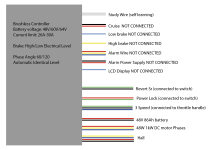




![review-piaggio-ape-50-europe[1].jpg review-piaggio-ape-50-europe[1].jpg](https://endless-sphere.com/sphere/data/attachments/186/186908-64bd92344f77312bd12d5c2135ae9231.jpg)
